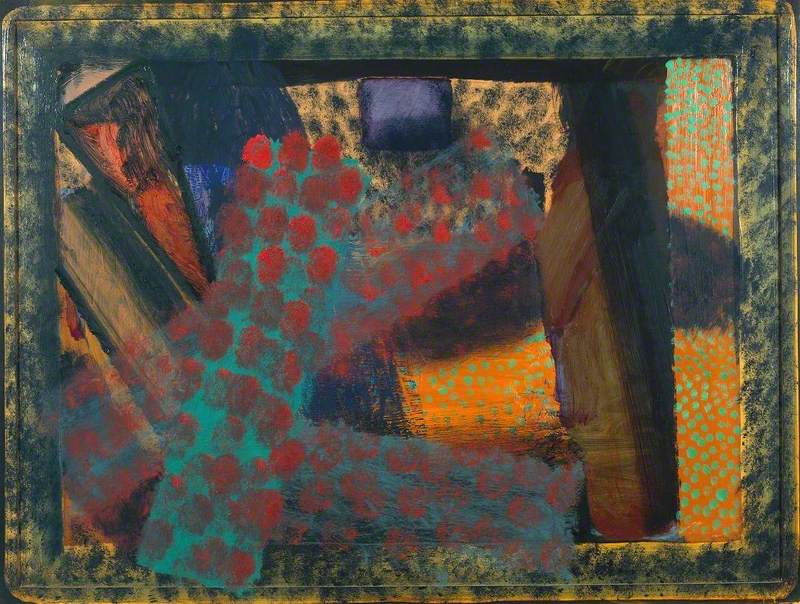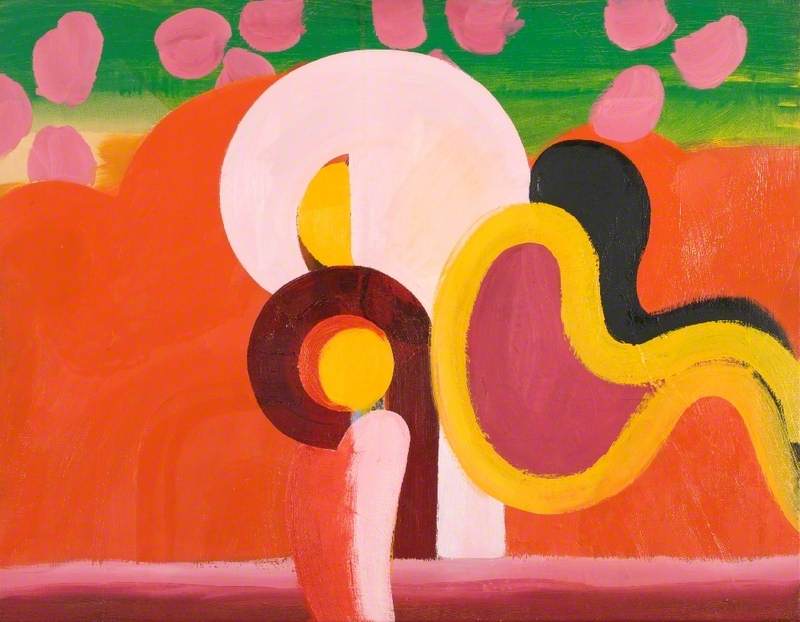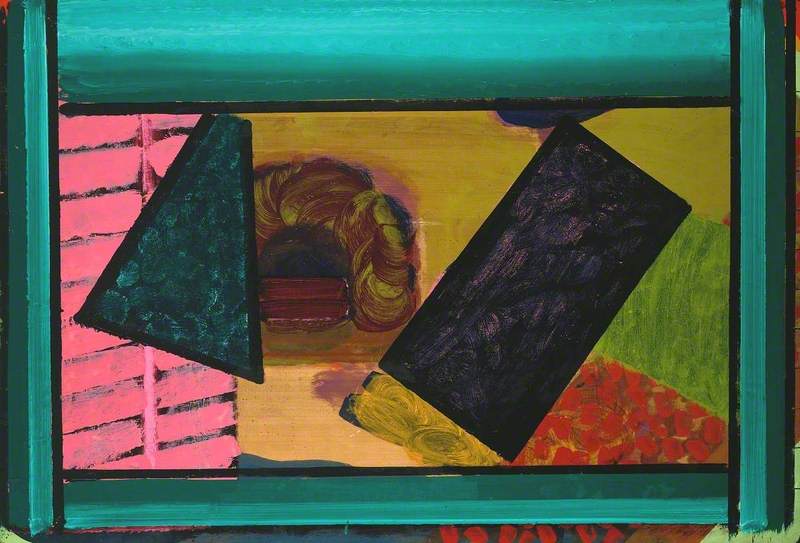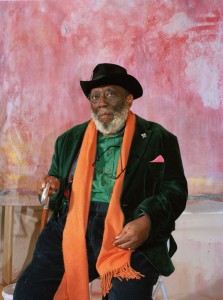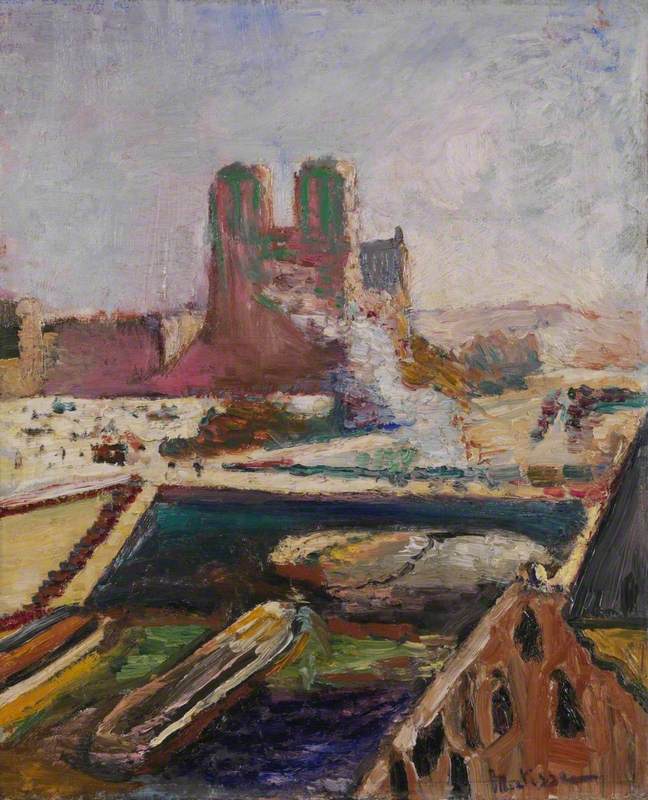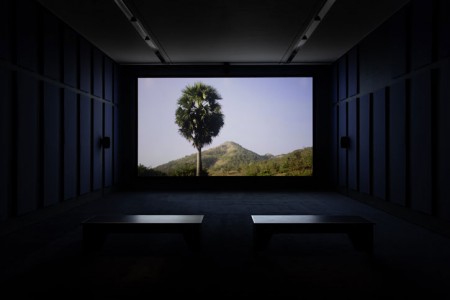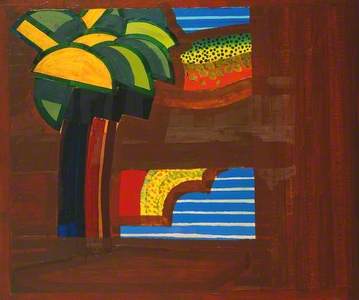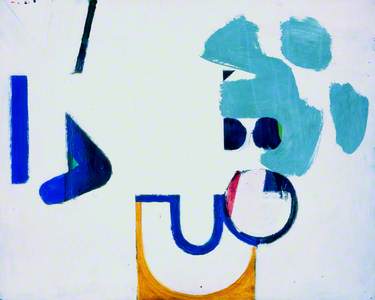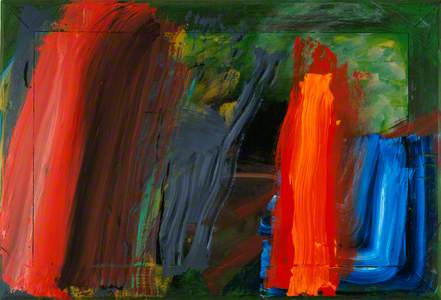In 1990, the British Council commissioned Indian architect Charles Correa to design a new set of offices in New Delhi. Two years later, British artist Howard Hodgkin (1932–2017) created an enormous mural which still adorns the building's facade. Rendered in black and white tiles, the artwork depicts a giant, gangly banyan tree, and is a tribute to Hodgkin's affection for India and the inspiration it gave him.
Hodgkin's passion for India blossomed after his first visit in 1964, and the colours he saw in the country informed his paintings throughout his life. Post-war Britain's relationship with colour reflected the aftermath of devastation, with the likes of Frank Auerbach, Leon Kossoff and Ben Nicholson often working with sober and restrained tones. Hodgkin broke through this, using colour to build his reputation as a game-changing artist.
Hodgkin was a late bloomer. Born into a comfortable middle-class family in London in 1932 – his mother was a botanical illustrator and his father a company director – Hodgkin endured a turbulent period of formative education. He ran away from most of the schools he was sent to, including Eton College, before settling at Camberwell School of Art (1949–1950) and Bath Academy of Art (1950–1954) to begin the process of becoming the artist he'd wanted to be since the age of five. Hodgkin married fellow art student Julia Lane in 1952 and went straight into teaching after leaving academia.
His painting Staff Meeting references his time on the faculty at Bath Academy of Art where he taught from 1956–1966. The brushwork, composition and structure show an artist on a search for his own style. Paint is layered inelegantly and the figures represented are cartoonish. But its importance lies in its conception. This is a recollection, not a work done from sketches or preparatory drawings. It is a memory – and this is how Hodgkin would come to work.
As his practice developed, Hodgkin's paintings moved from representing what was in front of him, albeit in an abstract manner (as in the above Gramophone, for example), to images conjured from his personal memory bank. Foy Nissen's Bombay, another work inspired by India, also emerged from a memory Hodgkin had of visiting Nissen's apartment when he was the British Council representative in Bombay.
Between 1966 and 1972, Hodgkin supported his artwork and family (he now had two young sons) by teaching at the Chelsea School of Art. The Second Visit and Large Staff Room reveal an increased confidence with colour and a diminishing interest in structure.
While The Second Visit has purposefully placed objects on show, escorting the viewer across the artwork, Large Staff Room is an exercise in colour domination, with a ruddy orange taking centre stage. The remaining colours are retained through a window-like viewpoint that leads the eye inside the work – a move that would become one of Hodgkin's compositional motifs. A long-time admirer of the spontaneity of Henri Matisse, Pierre Bonnard and Jackson Pollock, Hodgkin began painting on wooden boards he found lying about as his style began to reflect his heroes' painterly pyrotechnics.
In 2006, Hodgkin made The Independent on Sunday's Pink List, an appraisal of the UK's most influential gay men and women. To external observers, Hodgkin's marriage to Julia Lane had been unremarkable. However, by the mid-1970s Hodgkin felt comfortable enough to live his life as a gay man. Art historian and curator Nicholas Serota worked with Hodgkin on three of the artist's exhibitions (in 1976, 1985, and in 2006, during Serota's directorship of the Tate) and has theorised that Hodgkin's public embracing of his true sexuality had a liberating effect on his work.
Although Hodgkin dismissed the contention, this period reveals a marked change in his work. Painted between 1974 and 1976, Mr and Mrs Stephen Buckley shows an artist settling into his groove. The window-like motif is there as unidentifiable objects bounce confidently across Hodgkin's board. The use of colour is untrammelled, with shocking pinks rubbing against dirty ochres and greens, much like a scene from a market day in India. Hodgkin would still spend years on an artwork but now his paintings sizzled with vitality. Hodgkin and Lane separated in 1978 but remained friends.
Although Hodgkin had exhibited early in his career (a solo exhibition at Arthur Tooth & Sons in 1962 and as part of a group show at London's ICA in 1964), reactions had been unremarkable. By the end of the 1970s, though, the art world was tuning into Hodgkin's newfound exuberance. He received a CBE in 1977 and was asked to take part in the Hayward Gallery's annual survey of outstanding British art in 1980. More accolades followed: in 1984 Hodgkin represented Great Britain at the Venice Biennale, and the following year he won the Turner Prize. A knighthood followed in 1992.
Rain, painted between 1984 and 1989, encapsulates Hodgkin's entrance into his golden period as he uses paint to evoke the emotions and memories that relate to experience. Gloomier colours (forbidding monsoon clouds?) frame a sequence of coloured swipes that end just out of view, perhaps where the rain finally stops.
Hodgkin had continued to visit India annually to store up street scenes and incidents of colour in his mind, ready to be released onto board when he returned to the studio he had built in Bloomsbury in the early 1970s. He had also accrued one of the world's most admirable collections of Indian art during his trips, some of which were exhibited at the Ashmolean Museum in Oxford in 2012.
Following the completion of the New Delhi British Council building, Hodgkin embarked on a series of prints – he was also an accomplished printmaker – entitled 'Venetian Views'. Originally intended as small illustrations for a reprint of Thomas Mann's novel Death in Venice (1912), the unrealised project morphed into a stand-alone set of large-scale works based on imaginary views of the city. At just over one and a half metres by almost two in size, Venice, Evening is a complex work that successfully retains Hodgkin's ability to create chaotic planes of colour.
Hodgkin's appointment as a Companion of Honour in the Queen's 2003 New Year Honours List coincided with the run-up to his huge, Nicholas Serota-curated retrospective solo survey at Tate Britain. Along with the Venice series, the 2006 exhibition would feature 61 Hodgkin artworks, including contemporaneous works such as Come into the Garden, Maud, along with older pieces, including R. B. K. and Mr and Mrs E. J. P., made during the 1960s and 1970s.
The exhibition was accompanied by the Writers on Howard Hodgkin book, wherein the likes of Julian Barnes, Bruce Chatwin, Susan Sontag and others wrote in response to Hodgkin's work.
Hodgkin continued to work into later life. As Time Goes By (Red) from 2009 is a six-metre-wide print made from layers of paper, covered with paintball-like splats and hand-finished by the artist. More Hodgkin exhibitions were in the pipeline when the artist died peacefully in hospital in March 2017, aged 84. In fact, the National Portrait Gallery was in the middle of hanging the first-ever exhibition of Hodgkin's portraits as the news broke.
Entitled 'Absent Friends', the survey was a chance for Hodgkin to showcase how his use of memories and feelings evoked people as well as places, as well as illustrating how his own brand of abstraction moved portrait painting on from traditional portraiture.
The exhibition went ahead, with Simon Wallis, the gallery's then director, saying Hodgkin 'had been incredibly generous and the last six works in the show are the last six paintings he had made in India.'
Hodgkin and Susan Sontag had connected in 1991 when he provided illustrations for The Way We Live Now, Sontag's short story about the growing AIDS crisis. Her essay in the Writers on Howard Hodgkin book seized on the essence of one of contemporary art's greatest protagonists of the joy of colour and the sensations memory conveys. 'It may be that this painter needs to travel,' she wrote. 'You need the separation from home, and then you need the return home to consider what you have stored up. What is worth painting is what remains in, and is transformed by, memory.'
Simon Coates, writer
This content was supported by Jerwood Foundation



